Related Research Articles
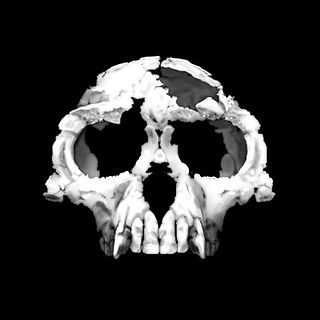
Ardipithecus is a genus of an extinct hominine that lived during the Late Miocene and Early Pliocene epochs in the Afar Depression, Ethiopia. Originally described as one of the earliest ancestors of humans after they diverged from the chimpanzees, the relation of this genus to human ancestors and whether it is a hominin is now a matter of debate. Two fossil species are described in the literature: A. ramidus, which lived about 4.4 million years ago during the early Pliocene, and A. kadabba, dated to approximately 5.6 million years ago. Initial behavioral analysis indicated that Ardipithecus could be very similar to chimpanzees, however more recent analysis based on canine size and lack of canine sexual dimorphism indicates that Ardipithecus was characterised by reduced aggression, and that they more closely resemble bonobos.

Science, also widely referred to as Science Magazine, is the peer-reviewed academic journal of the American Association for the Advancement of Science (AAAS) and one of the world's top academic journals. It was first published in 1880, is currently circulated weekly and has a subscriber base of around 130,000. Because institutional subscriptions and online access serve a larger audience, its estimated readership is over 400,000 people.

Thermus aquaticus is a species of bacteria that can tolerate high temperatures, one of several thermophilic bacteria that belong to the Deinococcota phylum. It is the source of the heat-resistant enzyme Taq DNA polymerase, one of the most important enzymes in molecular biology because of its use in the polymerase chain reaction (PCR) DNA amplification technique.
In chemistry, a superatom is any cluster of atoms that seem to exhibit some of the properties of elemental atoms.

Rudolf Grimm is an experimental physicist from Austria. His work centres on ultracold atoms and quantum gases. He was the first scientist worldwide who, with his team, succeeded in realizing a Bose–Einstein condensation of molecules.

Bert Vogelstein is director of the Ludwig Center, Clayton Professor of Oncology and Pathology and a Howard Hughes Medical Institute investigator at The Johns Hopkins Medical School and Sidney Kimmel Comprehensive Cancer Center. A pioneer in the field of cancer genomics, his studies on colorectal cancers revealed that they result from the sequential accumulation of mutations in oncogenes and tumor suppressor genes. These studies now form the paradigm for modern cancer research and provided the basis for the notion of the somatic evolution of cancer.
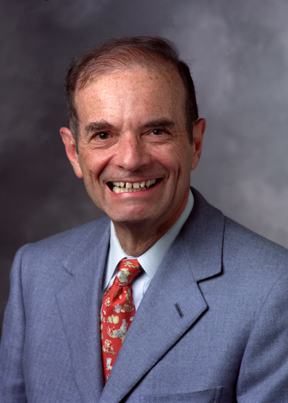
Lubert Stryer was the Emeritus Mrs. George A. Winzer Professor of Cell Biology, at Stanford University School of Medicine. His research over more than four decades has been centered on the interplay of light and life. In 2007 he received the National Medal of Science from President Bush at a ceremony at the White House for elucidating the biochemical basis of signal amplification in vision, pioneering the development of high density microarrays for genetic analysis, and authoring the standard undergraduate biochemistry textbook, Biochemistry. It is now in its tenth edition and also edited by Jeremy Berg, Justin Hines, John L. Tymoczko and Gregory J. Gatto, Jr.
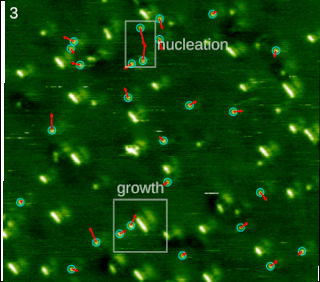
In chemistry and materials science, molecular self-assembly is the process by which molecules adopt a defined arrangement without guidance or management from an outside source. There are two types of self-assembly: intermolecular and intramolecular. Commonly, the term molecular self-assembly refers to the former, while the latter is more commonly called folding.

Daniel Edward Koshland Jr. was an American biochemist. He reorganized the study of biology at the University of California, Berkeley, and was the editor of the leading U.S. science journal, Science, from 1985 to 1995. He was a member of the United States National Academy of Sciences, the American Academy of Arts and Sciences, and the American Philosophical Society.

Molecular propeller is a molecule that can propel fluids when rotated, due to its special shape that is designed in analogy to macroscopic propellers: it has several molecular-scale blades attached at a certain pitch angle around the circumference of a shaft, aligned along the rotational axis.
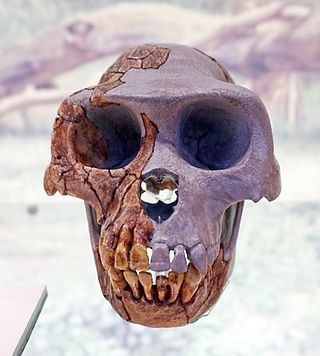
Ardipithecus ramidus is a species of australopithecine from the Afar region of Early Pliocene Ethiopia 4.4 million years ago (mya). A. ramidus, unlike modern hominids, has adaptations for both walking on two legs (bipedality) and life in the trees (arboreality). However, it would not have been as efficient at bipedality as humans, nor at arboreality as non-human great apes. Its discovery, along with Miocene apes, has reworked academic understanding of the chimpanzee–human last common ancestor from appearing much like modern-day chimpanzees, orangutans and gorillas to being a creature without a modern anatomical cognate.
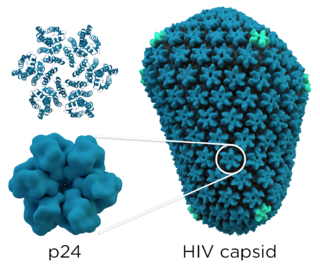
The P24 capsid protein is the most abundant HIV protein with each virus containing approximately 1,500 to 3,000 p24 molecules. It is the major structural protein within the capsid, and it is involved in maintaining the structural integrity of the virus and facilitating various stages of the viral life cycle, including viral entry into host cells and the release of new virus particles. Detection of p24 protein is used in various diagnostic assays, including antigen tests, to identify the presence of HIV in a person's blood. These tests are designed to detect viral antigens, such as p24, only in the acute phase of HIV infection. After approximately 50 days of infection, the p24 antigen is often cleared from the bloodstream entirely.

Robert Charles Gallo is an American biomedical researcher. He is best known for his role in establishing the human immunodeficiency virus (HIV) as the infectious agent responsible for acquired immune deficiency syndrome (AIDS) and in the development of the HIV blood test, and he has been a major contributor to subsequent HIV research.
Xiaowei Zhuang is a Chinese-American biophysicist who is the David B. Arnold Jr. Professor of Science, Professor of Chemistry and Chemical Biology, and Professor of Physics at Harvard University, and an Investigator at the Howard Hughes Medical Institute. She is best known for her work in the development of Stochastic Optical Reconstruction Microscopy (STORM), a super-resolution fluorescence microscopy method, and the discoveries of novel cellular structures using STORM. She received a 2019 Breakthrough Prize in Life Sciences for developing super-resolution imaging techniques that get past the diffraction limits of traditional light microscopes, allowing scientists to visualize small structures within living cells. She was elected a Member of the American Philosophical Society in 2019 and was awarded a Vilcek Foundation Prize in Biomedical Science in 2020.

A quantum machine is a human-made device whose collective motion follows the laws of quantum mechanics. The idea that macroscopic objects may follow the laws of quantum mechanics dates back to the advent of quantum mechanics in the early 20th century. However, as highlighted by the Schrödinger's cat thought experiment, quantum effects are not readily observable in large-scale objects. Consequently, quantum states of motion have only been observed in special circumstances at extremely low temperatures. The fragility of quantum effects in macroscopic objects may arise from rapid quantum decoherence. Researchers created the first quantum machine in 2009, and the achievement was named the "Breakthrough of the Year" by Science in 2010.

In biophysics and related fields, reduced dimension forms (RDFs) are unique on-off mechanisms for random walks that generate two-state trajectories (see Fig. 1 for an example of a RDF and Fig. 2 for an example of a two-state trajectory). It has been shown that RDFs solve two-state trajectories, since only one RDF can be constructed from the data, where this property does not hold for on-off kinetic schemes, where many kinetic schemes can be constructed from a particular two-state trajectory (even from an ideal on-off trajectory). Two-state time trajectories are very common in measurements in chemistry, physics, and the biophysics of individual molecules (e.g. measurements of protein dynamics and DNA and RNA dynamics, activity of ion channels, enzyme activity, quantum dots ), thus making RDFs an important tool in the analysis of data in these fields.

Nenad Ban is a biochemist born in Zagreb, Croatia who currently works at the ETH Zurich, Swiss Federal Institute of Technology, as a professor of Structural Molecular Biology. He is a pioneer in studying gene expression mechanisms and the participating protein synthesis machinery.

James Ellsworth Ferrell is an American systems biologist. He is a Professor of Chemical and Systems Biology and Biochemistry at Stanford University School of Medicine. He was Chair of the Dept. of Chemical and Systems Biology from its inception in 2006 until 2011.

NGC 4993 is a lenticular galaxy located about 140 million light-years away in the constellation Hydra. It was discovered on 26 March 1789 by William Herschel and is a member of the NGC 4993 Group.

CRISPR gene editing standing for "Clustered Regularly Interspaced Short Palindromic Repeats" is a genetic engineering technique in molecular biology by which the genomes of living organisms may be modified. It is based on a simplified version of the bacterial CRISPR-Cas9 antiviral defense system. By delivering the Cas9 nuclease complexed with a synthetic guide RNA (gRNA) into a cell, the cell's genome can be cut at a desired location, allowing existing genes to be removed and/or new ones added in vivo.
References
- ↑ "Journal metrics". Google Scholar. Retrieved 9 Jul 2020.
- ↑ "'Science' Names Molecule of the Year". The Chronicle of Higher Education. January 10, 1990.
- ↑ R. L. Guyer & D. E. Koshland, Jr. (1989). "The Molecule of the Year". Science . 246 (4937): 1543–1546. doi:10.1126/science.2688087. PMID 2688087.
- ↑ D. E. Koshland, Jr. (1990). "The Molecule of the Year". Science . 250 (4988): 1637. Bibcode:1990Sci...250.1637K. doi:10.1126/science.250.4988.1637. PMID 17734689.
- ↑ D. E. Koshland, Jr. (1991). "Molecule of the Year". Science . 254 (5039): 1705. Bibcode:1991Sci...254.1705K. doi:10.1126/science.254.5039.1705. PMID 17829221.
- ↑ D. E. Koshland, Jr. (1992). "The Molecule of the Year". Science . 258 (5090): 1861. Bibcode:1992Sci...258.1861K. doi:10.1126/science.1470903. PMID 1470903.
- ↑ D. E. Koshland, Jr. (1993). "Molecule of the Year". Science . 262 (5142): 1953. Bibcode:1993Sci...262.1953K. doi:10.1126/science.8266084. PMID 8266084.
- ↑ D. E. Koshland, Jr. (1994). "Molecule of the Year: the DNA repair enzyme". Science . 266 (5193): 1925. Bibcode:1994Sci...266.1925K. doi:10.1126/science.7801114. PMID 7801114.
- ↑ Michael Balter (1996). "BREAKTHROUGH OF THE YEAR. New Hope in HIV Disease". Science . 274 (5295): 1988–1991. Bibcode:1996Sci...274.1988.. doi:10.1126/science.274.5295.1988. PMID 8984652.
- ↑ Elizabeth Pennisi (1997). "BREAKTHROUGH OF THE YEAR. Cloning: The Lamb That Roared". Science . 278 (5346): 2038–2039. Bibcode:1997Sci...278.2038P. doi:10.1126/science.278.5346.2038. PMID 9432711. S2CID 83255402.
- ↑ James Glanz (1998). "BREAKTHROUGH OF THE YEAR. ASTRONOMY: Cosmic Motion Revealed". Science . 282 (5397): 2156–2157. Bibcode:1998Sci...282.2156G. doi:10.1126/science.282.5397.2156a. S2CID 117807831.
- ↑ Gretchen Vogel (1999). "BREAKTHROUGH OF THE YEAR. Capturing the Promise of Youth". Science . 286 (5448): 2238–2239. doi:10.1126/science.286.5448.2238. PMID 10636772. S2CID 154178515.
- ↑ Elizabeth Pennisi (2000). "BREAKTHROUGH OF THE YEAR. Genomics Comes of Age". Science . 290 (5500): 2220–2221. doi:10.1126/science.290.5500.2220. PMID 11188701. S2CID 82676530.
- ↑ Robert F. Service (2001). "BREAKTHROUGH OF THE YEAR. Molecules Get Wired". Science . 294 (5551): 2442–2443. doi:10.1126/science.294.5551.2442. PMID 11752536. S2CID 26182334.
- ↑ Jennifer Couzin (2002). "BREAKTHROUGH OF THE YEAR. Small RNAs Make Big Splash". Science . 298 (5602): 2296–2297. doi:10.1126/science.298.5602.2296. PMID 12493875. S2CID 193861470.
- ↑ Charles Seife (2003). "BREAKTHROUGH OF THE YEAR. Illuminating the Dark Universe". Science . 302 (5653): 2038–2039. doi: 10.1126/science.302.5653.2038 . PMID 14684787. S2CID 120116611.
- ↑ Richard A. Kerr (2004). "BREAKTHROUGH OF THE YEAR. On Mars, a Second Chance for Life". Science . 306 (5704): 2010–2012. doi: 10.1126/science.306.5704.2010 . PMID 15604365. S2CID 140193176.
- ↑ Elizabeth Culotta, Elizabeth Pennisi (2005). "BREAKTHROUGH OF THE YEAR. Evolution in Action". Science . 310 (5756): 1878–1879. doi: 10.1126/science.310.5756.1878 . PMID 16373538.
- ↑ Dana Mackenzie (2006). "BREAKTHROUGH OF THE YEAR. The Poincaré Conjecture—Proved". Science . 314 (5807): 1848–1849. doi: 10.1126/science.314.5807.1848 . PMID 17185565.
- ↑ Elizabeth Pennisi (2007). "BREAKTHROUGH OF THE YEAR. Human Genetic Variation". Science . 318 (5858): 1842–1843. doi:10.1126/science.318.5858.1842. PMID 18096770.
- ↑ Gretchen Vogel (2008). "BREAKTHROUGH OF THE YEAR. Reprogramming Cells". Science . 322 (5909): 1766–1767. doi:10.1126/science.322.5909.1766. PMID 19095902.
- ↑ Ann Gibbons (2009). "BREAKTHROUGH OF THE YEAR. Ardipithecus ramidus". Science . 326 (5960): 1598–1599. Bibcode:2009Sci...326.1598G. doi:10.1126/science.326.5960.1598-a. PMID 20019252.
- ↑ Adrian Cho (2010). "BREAKTHROUGH OF THE YEAR. The First Quantum Machine". Science . 330 (6011): 1604. Bibcode:2010Sci...330.1604C. doi:10.1126/science.330.6011.1604. PMID 21163978.
- ↑ Jon Cohen (2011). "BREAKTHROUGH OF THE YEAR. HIV Treatment as Prevention". Science . 334 (6063): 1628. Bibcode:2011Sci...334.1628C. doi:10.1126/science.334.6063.1628. PMID 22194547.
- ↑ "Breakthrough of the Year, 2012". Science.
- ↑ Jenifer Couzin-Franken (20 December 2013). "Cancer Immunotherapy". Science. 342 (6165): 1432–1433. doi:10.1126/science.342.6165.1432 . Retrieved 22 December 2013.
- ↑ Eric Hand (19 December 2014). "Comet rendezvous". Science. 346 (6216): 1442–1443. doi:10.1126/science.346.6216.1442. PMID 25525223 . Retrieved 20 December 2014.
- ↑ Travis, John (2015-12-18). "Making the cut | Science". Science. 350 (6267). Sciencemag.org: 1456–1457. doi:10.1126/science.350.6267.1456 . Retrieved 2017-11-09.
- ↑ Cho, Adrian (2016). "The cosmos aquiver". Science. 354 (6319): 1516–1517. Bibcode:2016Sci...354.1516C. doi:10.1126/science.354.6319.1516. PMID 28008020.
- ↑ "Ripples in spacetime: Science's 2016 Breakthrough of the Year". Adiran Cho. AAAS. 22 December 2016. Retrieved 23 December 2016.
- ↑ "The runners-up". Science. 354 (6319): 1518–1523. 2016. doi:10.1126/science.354.6319.1518. PMID 28008021.
- ↑ "Breakthrough of the year 2017". Science | AAAS. 22 December 2017.
- ↑ Cho, Adrian (2017). "Cosmic convergence". Science. 358 (6370): 1520–1521. Bibcode:2017Sci...358.1520C. doi:10.1126/science.358.6370.1520. PMID 29269456.
- ↑ Stokstad, Erik; Pennisi, Elizabeth; Kaiser, Jocelyn; Cohen, Jon; Couzin-Frankel, Jennifer; Voosen, Paul; Gibbons, Ann; Cho, Adrian (2017). "The runners up". Science. 358 (6370): 1522–1527. Bibcode:2017Sci...358.1522S. doi:10.1126/science.358.6370.1522. PMID 29269457.
- ↑ "Breakthrough of the year 2018". Science | AAAS. 20 December 2018.
- ↑ Phelan, Meagan; Beckwith, Walter (19 December 2019). "Science's 2019 Breakthrough: First Image of Supermassive Black Hole". American Association for the Advancement of Science . Retrieved 20 December 2019.
- ↑ American Association for the Advancement of Science (19 December 2019). "Science's 2019 breakthrough of the year: The first image of a black hole". EurekAlert! . Retrieved 20 December 2019.
- ↑ Cohen, Jon (17 December 2020). "Shots of hope". Science. American Association for the Advancement of Science.
- ↑ "Protein structures for all". Science. American Association for the Advancement of Science. 16 December 2021.
- ↑ "2022 BREAKTHROUGH OF THE YEAR". Science. American Association for the Advancement of Science. 24 December 2022.
- ↑ Couzin-Frankel, Jennifer. "2023 BREAKTHROUGH OF THE YEAR". Science. American Association for the Advancement of Science. Retrieved 19 December 2023.